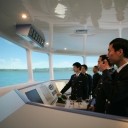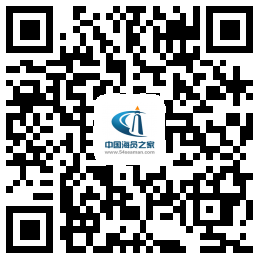泵的种类 - 请对照学习
以下是我在做实习生的时候摘录的一些基本知识,大家可以结合中文教材学习
希望各位贤兄有所收获
^_^ 获取晋级 :)P
Types of pumps
The pumps employed on board ship can be divided into two main categories: (i) positive displacement pumps and (ii) centrifugal pumps. They can be broken down into three classes: (1) reciprocating, (2) rotary and (3) centrifugal. Under reciprocating are the direct acting, power, and crank-fly-wheel types. Under rotary are the gear, vane, cam-and-piston and screw types. Under centrifugal are the volute, diffuser, mixed-flow, axial-flow and turbine or regenerative types.
Displacement pumps are those where the volume of the pump chamber is alternately increased to draw the liquid in from the suction pipe and then decreased to force the liquid out into the delivery pipe. Centrifugal pumps are those wherein an impeller rotating at high speed throws the liquid by centrifugal force from the center to the periphery of the impeller where the liquid is discharged through the delivery outlet.
Gear pumps consist of two or more gears (spur, single or double helical teeth). They are positive-displacement type because they discharge a near constant amount of liquid regardless of pressure. If the discharge valve is closed, they build up a bursting pressure or stall their motor. Centrifugal pumps are noo-positive and a fairly low pressure unit. Here a closed discharge valve will not cause excessive pressure to build up.
In general, reciprocating pumps are suitable for delivering small quantities at high pressure, rotary pumps are used for moderate quantities at moderate pressure, and centrifugal pumps are more suitable for large quantities at low pressure. Centrifugal pumps, however, can be designed with a number of impellers in series to attain a high final delivery pressure. They are popular because they are very *** in construction, and can produce smooth, constant, non-pulsating discharge.
Pumps used on tanker
a. Centrifugal Pump: an impreller rotating at high speed in chamber,it throws the liquid by centrifugal force from centre to periphery of the impreller, then the liquid is discharged through the delivery outlet.
The three cargo oil pumps and the two ballast pumps are centrifugal type pump.
b. Positive displacement pump: the volume of the pump chamber is alternately increased to draw the liquid in from the suction pipe and then decreased to force the liquid out into the delivery pipe.The reciprocating pumps and the rotary pumps are positive displacement pumps.The reciprocating pumps are suitable for delivery small quanties at high pressure, and the rotary pumps are for moderate quanties at low pressure, like for discharging bilge.
c. Gear pump: consist of two or more meshing gears with helical teeth, enclosed in a close-fitted housing. When the gears unmeshed on inlet side, a pressure drop occurs,it hleps the atmosphere pressure acting on the su***ce of liquid to force it up to fill void,as the gear teeth mesh again on the outlet side,they form a seal to prevent liquid from backing up to inlet,then the liquid is forced out into the discharge line. They can be used for pumping fuel oil,lubricating oil and hydrolic oil.
d. Diaphragm pump: one of the positive displacement pumps. One spring is connected to the chamber,when the spring is stretched, the chamber volume is increased to draw the liquid in and when the spring is constringent, the chamber volume is decreased to forced the liquid out.The wilden pumps are this type.
stripping pump suction strainer (SCOMPMAN 4-4-11 Straioer)
Main and stripping pump strainers are to be opened and cleaned at frequent intervals according to PIMS or as found necessary.
The frequency of inspections depends largely upon the trade in which the ship is engaged.
C/O told us that we'd better clean the strainer after each discharging operation. If unconveniently,cleaning of the strainer shuld be carried out every three months.
-----------------------------------------------------
2nd Officer
Ever-student from Dalian Maritime University
Be proud of DMU
请登录后发帖

 联系我们人工客服
联系我们人工客服



















 :1391995811
:1391995811

